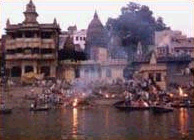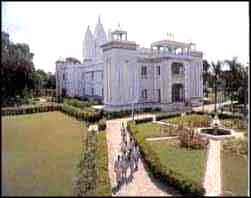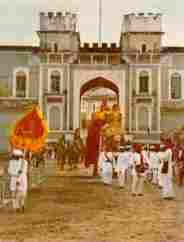|
|
VARANASI
![]()
 This early morning sunrise boat cruise
at holy river Ganges visiting Ghats and seeing people taking holy dip and
worshiping, The city of Shiva on the bank of the sacred Ganges is
one of the holiest places in India. Hindu pilgrims come to bathe in the
waters of the Ganges, a ritual which washes away all sins. The city, also
known as Benares (or Banares), is an auspicious place to die, since
expiring here ensures release from the cycle or rebirths and an instant
passport to heaven. It’s a magical city where the most intimate rituals
of life and death take place in public on the city’s famous ghats (steps
which lead down to the river). It’s this accessibility to the practices
of an ancient religious tradition that captivates so many visitors.
In
the past, the city has been known as Kashi and Benares, but its present
name is a restoration of an ancient name meaning the city between two
rivers- the Varuna and Assi. It has been center of learning and civilsation for
over 2000 years, and claims to be one of the oldest living cities in the
world. The old city does have an antique feel but few buildings are more
than a couple of hundred years old thanks to marauding Muslim invaders and
Aurangzeb’s destructive tendencies. This early morning sunrise boat cruise
at holy river Ganges visiting Ghats and seeing people taking holy dip and
worshiping, The city of Shiva on the bank of the sacred Ganges is
one of the holiest places in India. Hindu pilgrims come to bathe in the
waters of the Ganges, a ritual which washes away all sins. The city, also
known as Benares (or Banares), is an auspicious place to die, since
expiring here ensures release from the cycle or rebirths and an instant
passport to heaven. It’s a magical city where the most intimate rituals
of life and death take place in public on the city’s famous ghats (steps
which lead down to the river). It’s this accessibility to the practices
of an ancient religious tradition that captivates so many visitors.
In
the past, the city has been known as Kashi and Benares, but its present
name is a restoration of an ancient name meaning the city between two
rivers- the Varuna and Assi. It has been center of learning and civilsation for
over 2000 years, and claims to be one of the oldest living cities in the
world. The old city does have an antique feel but few buildings are more
than a couple of hundred years old thanks to marauding Muslim invaders and
Aurangzeb’s destructive tendencies.
GHATS
 Varanasi’s principal attraction is the long string
of ghats, which line the western bank of the Ganges. Most are used for
bathing but there are also several ‘burning ghats’ where bodies are
cremated. The best time to visit the ghats is at dawn when the river is
bathed in a magical light and pilgrims come to perform puja to the rising
sun.
Varanasi’s principal attraction is the long string
of ghats, which line the western bank of the Ganges. Most are used for
bathing but there are also several ‘burning ghats’ where bodies are
cremated. The best time to visit the ghats is at dawn when the river is
bathed in a magical light and pilgrims come to perform puja to the rising
sun.
There are around 100 ghats in Varanasi, but Dasaswamedh Ghat is
probably the most convenient starting point. A short boat trip can be
interesting introduction to the river. Alternatively, if the water level
is low, you can simply walk from one ghat to the next. This way you’re
among the throng to the next. This way you’re among of the Ganges not
only for a ritual bath, but to do yoga, offer blessings, buy paan, sell
flowers, get a massage, play cricket, have a swim, get a shave, and
improve their karma by giving money to beggars. The city extends from Raj Ghat, near the major road and Rail
Bridge, to Assi Ghat, is one of the five special ghats which
pilgrims are supposed to bathe at in sequence during the ritual route
called Panchatirthi Yatra. The order is Assi, Dasaswamedh, Adi Keshava,
Panchganga and finally Manikarnika.
The city extends from Raj Ghat, near the major road and Rail
Bridge, to Assi Ghat, is one of the five special ghats which
pilgrims are supposed to bathe at in sequence during the ritual route
called Panchatirthi Yatra. The order is Assi, Dasaswamedh, Adi Keshava,
Panchganga and finally Manikarnika.
Much
of the Tulsi Ghat has fallen down towards the river. The Bachraj
Ghat is Jain and there are three riverbank Jain Temples. Many of the
ghats are owned by maharajas or other princely rulers, such as the very
fine Shivala Ghat owned by the maharaja of Varanasi. The Dandi
Ghat is the ghat of ascetics known as Dandi Panths, and nearby is the
very popular Hanuman Ghat.
The
Harishchandra or Smashan Ghat is a secondary burning ghat. It’s
one of the oldest ghats in the city. Above it, the crowded Kedar Ghat
is a shrine popular with Bengalis and south Indians. Mansarowar Ghat
was built by Raja Man Singh of Amber and named after the Tibetan lake at
the foot of Mt. Kailash. Shiva’s Himalayan home. Someswar or Lord
of the Moon Ghat is said to be able to heal diseases. The Munshi Ghat
is very picturesque, while Ahalya Bai’s Ghat is named after the
female Maratha ruler of Indore.
The name of Dasaswamedh Ghat indicates that Brahma
sacrificed (medh) 10 (das) horses (aswa) here.
Conveniently central, it’s one of the most important and busiest ghats
and therefore is a good place to linger and soak up the atmosphere. Note
its statues and the shrine of Sitala, goddess of smallpox.
Raja
Man Singh’s Man Mandir Ghat was built in 1600 but was poorly
restored in the 19th century. The northern corner of the ghat
has a fine stone balcony and Raja Jai Singh of Jaipur erected one of his
unusual observatories on this ghat in 1710.
The
Meer Ghat leads to the Nepalese Temple, which has erotic
sculptures. The Jalsain Ghat, where cremations take place,
virtually adjoins Manikarnika Ghat, one of the oldest and most
sacred in Varanasi. Manikarnika is the main burning ghat and one of the
most auspicious places that a Hindu can be cremated. Bodies are handled by
outcasts known as doms, and they are carried through the alleyways of the
old city to the holy Ganges on a bamboo stretcher swathed in cloth. The
corpse is doused in the Ganges prior to cremation. You’ll see huge piles
of firewood stacked along the top of the ghat, each log carefully weighed
on giant scales so that the price of cremation can be calculated. There
are no problems watching cremations, since at Manikarnika death is simply
business as usual, but don’t take photos and keep your camera well
hidden. one of the oldest and most
sacred in Varanasi. Manikarnika is the main burning ghat and one of the
most auspicious places that a Hindu can be cremated. Bodies are handled by
outcasts known as doms, and they are carried through the alleyways of the
old city to the holy Ganges on a bamboo stretcher swathed in cloth. The
corpse is doused in the Ganges prior to cremation. You’ll see huge piles
of firewood stacked along the top of the ghat, each log carefully weighed
on giant scales so that the price of cremation can be calculated. There
are no problems watching cremations, since at Manikarnika death is simply
business as usual, but don’t take photos and keep your camera well
hidden.
![]()
Above
the steps here is a tank known as the Manikarnika Well; Parvati is
said to have dropped her earring here and Shiva dug the tank to recover
it, filling he depression with his sweat. The Charanpaduka, a slab
of stone between the well and the ghat, bears foot-prints made by Vishnu.
Privileged VIPs are cremated at the Charanpaduka. There is also a temple
dedicated to Ganesh on the ghat.
Dattatreya
Ghat bears the footprint of the Brahmin saint of that naming a small
temple nearby. Scindia Ghat was originally built in 1830 but was so
huge and magnificent that it collapsed into the river and had to be
rebuilt. The Ram Ghat was built by the raja or Jaipur. The Panchganga
Ghat, as its name indicates, is where five rivers are supposed to
meet.
![]() Dominating the ghat is Aurangzeb’s smaller mosque, also known as
the Alamgir Mosque, which he built on the site of a large Vishnu
Temple erected by the Maratha chieftain Beni Madhav Rao Scindia. The Gai
Ghat has a figure of a cow made of stone upon it. The Trilochan
Ghat has tow turrets emerging from the river, and the water between
them is especially holy. Raj Ghat was the ferry pier until the road
and rail bridge was completed here. Dominating the ghat is Aurangzeb’s smaller mosque, also known as
the Alamgir Mosque, which he built on the site of a large Vishnu
Temple erected by the Maratha chieftain Beni Madhav Rao Scindia. The Gai
Ghat has a figure of a cow made of stone upon it. The Trilochan
Ghat has tow turrets emerging from the river, and the water between
them is especially holy. Raj Ghat was the ferry pier until the road
and rail bridge was completed here.
Vishwanath Temple
![]()
The Vishwanath Temple, or Golden Temple, is the most
sacred temple in Varanasi and is dedicated to Vishveswara- Shiva as lord
of the universe. The current temple was built in 1776 by Ahalya Bai of
Indore, and the 800 kg of gold plating on the towers, which gives the
temple its colloquial name, was provided by Maharaja Ranjit Singh of
Lahore some 50 years later. It’s located in the narrow alleys of the old
city. Non- Hindus are not allowed into the temple but can view it from the
upper floor of a house across the street.
There has been a succession of Shiva temples in the vicinity for at
least the past 1500 years, but they were routinely destroyed by Muslim
invaders. Aurangzeb continued this tradition, knocking down the previous
temple and building his Great Mosque over it.
Next
to the Vishwanath Temple is the Gyan Kupor Well (Well of
Knowledge). The faithful believe drinking its water leads to a higher
spiritual plane, though they are prevented from doing so by both tradition
and a strong security screen. The well is said to contain the Shiva lingam
removed from the previous temple and hidden to protect it from Aurangzeb.
Durga Temple
![]() The Durga Temple is commonly known as the Monkey
Temple due to the many frisky monkeys that have made it their home.
Located about 2km south of the old city, this small temple was built in
the 18th century by a Bengali maharani and is stained red with
ochre. It’s in north Indian Nagara style with a multi-tiered shikhara
(spire). Durga is the ‘terrible’ form of Shiva’s consort Parvati, so
at festivals there are often sacrifices of goats. Non –Hindus can enter
the courtyard but not the inner sanctum.
The Durga Temple is commonly known as the Monkey
Temple due to the many frisky monkeys that have made it their home.
Located about 2km south of the old city, this small temple was built in
the 18th century by a Bengali maharani and is stained red with
ochre. It’s in north Indian Nagara style with a multi-tiered shikhara
(spire). Durga is the ‘terrible’ form of Shiva’s consort Parvati, so
at festivals there are often sacrifices of goats. Non –Hindus can enter
the courtyard but not the inner sanctum.
Tulsi Manas Temple

Only 150m south of the Durga Temple is the modern
marble shikhara-style Tulsi Manas Temple, built in 1964. Its two-tier
walls are engraved with verses and scenes from the Ram Charit Manas,
the Hindi version of the Ramayana. Its author, poet Tulsi Das,
lived here while writing it.
Benares Hindu University
![]() Varanasi has long been a center of learning and that
tradition is continued today at the Benares Hindu University (BHU), built
in 1917. It was founded by the great nationalist Pandit Malaviya as a
center for education in Indian art, music, culture and philosophy, and for
the study of Sanskrit. The five sq km campus houses the Bharat Kala
Bhavan which has a fine collection of miniature paintings, sculptures
from the 1st to 15th centuries and old photographs
of Varanasi.
Varanasi has long been a center of learning and that
tradition is continued today at the Benares Hindu University (BHU), built
in 1917. It was founded by the great nationalist Pandit Malaviya as a
center for education in Indian art, music, culture and philosophy, and for
the study of Sanskrit. The five sq km campus houses the Bharat Kala
Bhavan which has a fine collection of miniature paintings, sculptures
from the 1st to 15th centuries and old photographs
of Varanasi.
New Vishwanath Temple
It’s about a 30-minute walk from the gates of the
university to the New Vishwanath Temple, which was planned by Pandit
Malaviya and built by the wealthy Birla family of industrialists. Pandit
Malaviya wished to see Hinduism revived without its caste distinctions and
prejudices – accordingly, unlike many temples in Varanasi, this temple
is open to all, irrespective of caste or religion. The interior has a
Shiva lingam on the walls. The temple is supposed to be a replica of the
earlier Vishwanath Temple destroyed by Aurangzeb.
Ram Nagar Fort & Museum
 On the opposite bank of the river, this 17th
century fort is the home of the former maharaja of Benares. It looks most
impressive from the river, thought the decrepit planking of the pontoon
bridge you cross to reach it is somewhat of a distraction. During the
museum here contains old silver and brocade palanquins for the ladies of
the court, gold-plated elephant howdahs (seats for carrying people on an
elephant’s back), an astrological clock, macabre elephants traps and an
armoury of swords and old guns.
On the opposite bank of the river, this 17th
century fort is the home of the former maharaja of Benares. It looks most
impressive from the river, thought the decrepit planking of the pontoon
bridge you cross to reach it is somewhat of a distraction. During the
museum here contains old silver and brocade palanquins for the ladies of
the court, gold-plated elephant howdahs (seats for carrying people on an
elephant’s back), an astrological clock, macabre elephants traps and an
armoury of swords and old guns.
Bharat Mata Temple
![]() Dedicated to ‘ Mother India’, this unadorned
temple has a marble relief map of India instead of the usual images of
gods and goddesses. The map is said to be perfectly in scale, both
vertically and horizontally.
Dedicated to ‘ Mother India’, this unadorned
temple has a marble relief map of India instead of the usual images of
gods and goddesses. The map is said to be perfectly in scale, both
vertically and horizontally.
Shopping
Varanasi is famous throughout India for silk brocades
and beautiful Benaraes saris. However, there are lots of rip-off merchants
and commission people at work.
There’s
a market west of the main post office called Golghar where the makers of
silk brocades sell directly to local shop. Varanasi is also renowned for
its ingenious toys, musical instruments and expensive Bhadohi carpets.
|





